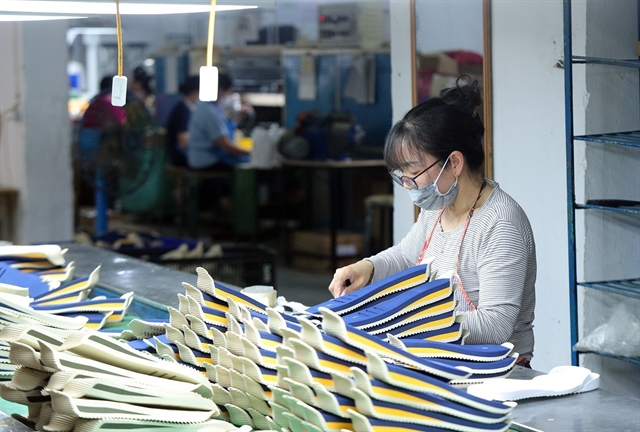 Economy
Economy


|
| Production at Vĩnh Phú Footwear Company in Đà Nẵng. — VNA/VNS Photo Tuấn Anh |
HÀ NỘI — Raising localisation rates in Việt Nam’s supporting industries is seen as crucial to reducing import dependence, enhancing competitiveness and laying a firm foundation for industrial growth.
According to the Ministry of Industry and Trade (MoIT), supporting industries serve as the backbone of major manufacturing sectors by supplying components, parts and technical processes. With strong policy backing from the Government and MoIT in recent years, the sector has recorded encouraging progress.
Yet, challenges remain.
Despite policy focus on textiles, footwear, electronics, autos, machinery, hi-tech products, materials and metallurgy, most industries continue to face hurdles. Experts point to the limited capacity of domestic firms, which hampers their ability to seize opportunities from foreign direct investment (FDI). Localisation rates remain modest – 45-50 per cent in textiles and footwear, 15–20 per cent in machinery, and only 5-20 per cent in autos.
In electronics, despite major investments from global giants such as Samsung, Apple, LG and Intel, localisation remains low, with Vietnamese suppliers largely restricted to simple, low-value components.
The MoIT’s Department of Industry noted that due to the nature of supporting industry production and the low starting point of domestic firms, many companies are unable to meet requirements to benefit from existing incentives, complicating policy implementation.
Encouraging equipment localisation
Chu Việt Cường, director of the MoIT’s Industrial Development Support Centre, said that synchronised measures ranging from process standardisation to cost support and bilateral cooperation would be needed to build sustainable supply chains, advance industrialisation and modernisation and deepen Việt Nam’s global integration.
Efforts to boost equipment localisation have already produced some results.
Trường Hảo Group Corporation (Trường Hải Group) has shortened bus and truck design processes through mastering calculations, simulation design and equipment assembly. The company is also working on a new-generation bus and upgrading components with eco-friendly materials and technologies.
Meanwhile, the Institute of Mechanical Engineering under MoIT has successfully designed and manufactured auxiliary equipment, gradually mastering factory design and hydro-mechanical equipment production for major hydropower projects, including the Sơn La (2,400 MW) and Lai Châu (1,200 MW) plants.
Looking ahead, MoIT plans to advise the Government on refining policies to attract investment into supporting industries, raise localisation rates and establish industrial clusters led by key enterprises and backed by comprehensive services.
Policy momentum for growth
Trương Thị Chí Bình, general secretary of the Vietnam Association of Supporting Industries (VASI), emphasised the need for stronger mechanisms to ensure foreign-invested enterprises (FDI) fulfil their localisation commitments and cooperate with domestic firms. She called for a balance of incentives and penalties to ensure compliance.
Bình underlined that stronger and more consistent policies are essential to further drive the development of Việt Nam’s supporting industries, alongside the efforts of businesses themselves.
Recently, the Government issued Decree 205/2025/NĐ-CP, amending Decree 111/2015, to strengthen support for research, application and technology transfer in priority products.
For joint research and technology transfer projects between enterprises and scientific organisations, support may cover up to 50 per cent of costs for machinery, equipment, design, training, intellectual property and consultancy. In some cases, funding may rise to 70 per cent for projects aimed at improving consultancy and expert capacity in the sector. — VNS




